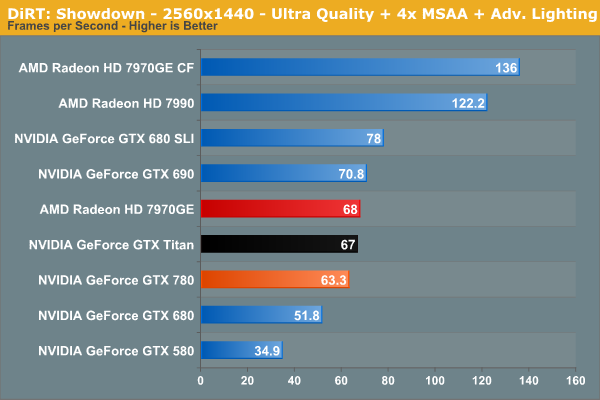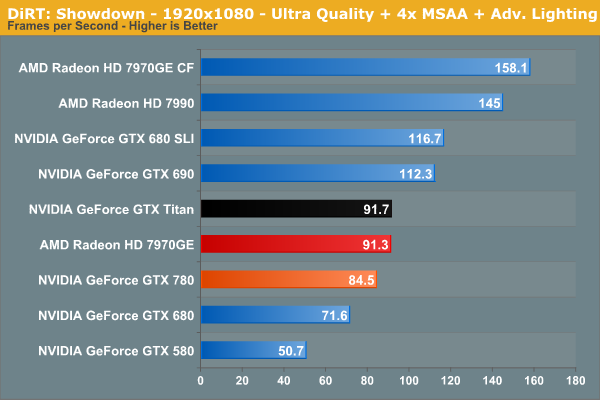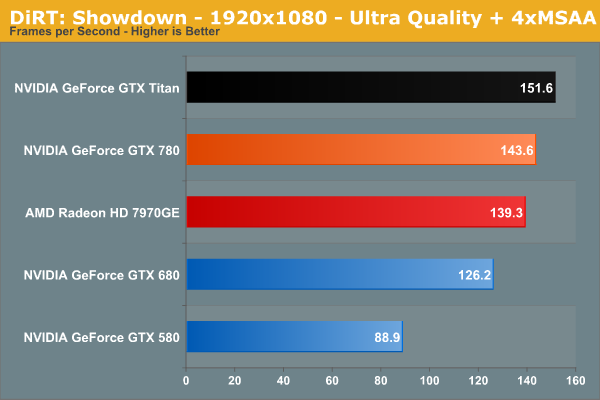NVIDIA GeForce GTX 780 Review: The New High End
by Ryan Smith on May 23, 2013 9:00 AM ESTDiRT: Showdown
As always, starting off our benchmark collection is our racing benchmark, DiRT: Showdown. DiRT: Showdown is based on the latest iteration of Codemasters’ EGO engine, which has continually evolved over the years to add more advanced rendering features. It was one of the first games to implement tessellation, and also one of the first games to implement a DirectCompute based forward-rendering compatible lighting system. At the same time as Codemasters is by far the most prevalent PC racing developers, it’s also a good proxy for some of the other racing games on the market like F1 and GRID.




DiRT: Showdown’s lighting system continues to befuddle us at times. Though GK10x Kepler parts generally have mediocre compute performance in pure compute tasks, NVIDIA’s DirectCompute performance has otherwise proven to be appropriately fast, except in the case of DiRT. The fact of the matter is that DiRT is easy enough to run even with its advanced lighting system that there’s no reason not to use it on a card like the GTX 780 at any single-monitor resolution, but doing so does put the GTX 780 in a bad light relative to AMD’s best cards. Nor does this put GK110 in a particularly good light, as its compute enhancements don’t bring it much of an advantage here beyond what the larger number of shaders affords.
Like Titan before it, the GTX 780 falls slightly behind AMD’s Radeon HD 7970 GHz Edition, the only such benchmark where this occurs. The end result being that the GTX 780 trails the 7970GE by about 7%, and the GTX Titan by 6%. Otherwise we’ve seen Titan (and will see GTX 780) do much better in virtually every other benchmark.










155 Comments
View All Comments
aidivn - Thursday, May 23, 2013 - link
so, how many Double Precision units are there in each SMX unit of gtx780? titan had 64 dp units in each of their SMX units which totaled to 896 dp unitsAnd can u turn them on or off from the forcewre driver menu like “CUDA – Double Precision” for gtx780?
Ryan Smith - Thursday, May 23, 2013 - link
Hardware wise this is GK110, so the 64 DP units are there. But most of them would be disabled to get the 1/24 FP64 rate.aidivn - Friday, May 24, 2013 - link
so how many are disabled and how many are enabled (numbers please)?Ryan Smith - Friday, May 24, 2013 - link
You would have only 1/8th enabled. So 8 per SMX are enabled, while the other 56 are disabled.aidivn - Saturday, May 25, 2013 - link
so, the GTX780 only has 96 DP units enabled while the GTX TITAN has 896 DP units enabled...thats a huge cut on double precisionDanNeely - Sunday, May 26, 2013 - link
That surprised me too. Previously the cards based on the G*100/110 cards were 1/8; this is a major hit vs the 580/480/280 series cards.Old_Fogie_Late_Bloomer - Thursday, May 23, 2013 - link
"GTX 780 on the other hand is a pure gaming/consumer part like the rest of the GeForce lineup, meaning NVIDIA has stripped it of Titan’s marquee compute feature: uncapped double precision (FP64) performance. As a result GTX 780 can offer 90% of GTX Titan’s gaming performance, but it can only offer a fraction of GTX Titan’s FP64 compute performance, topping out at 1/24th FP32 performance rather than 1/3rd like Titan."Seriously, this is just...it's asinine. Utterly asinine.
tipoo - Thursday, May 23, 2013 - link
Market segmentation is nothing new. The Titan really is a steal if you need DP, the next card up is 2400 dollars.Old_Fogie_Late_Bloomer - Thursday, May 23, 2013 - link
I'm well aware of the existence of market segmentation, but this is just ridiculous. Putting ECC RAM on professional cards is segmentation. Disabling otherwise functional features of hardware, most likely in the software drivers...that's just...ugh.SymphonyX7 - Thursday, May 23, 2013 - link
I just noticed that the Radeon HD 7970 Ghz Edition has been trouncing the GTX 680 in most of the benchmarks and trailing the GTX 680 in those benchmarks that traditionally favored Kepler. What the heck just happened? Didn't the review of the Radeon HD 7970 Ghz Edition say that it was basically tied with the GTX 680?